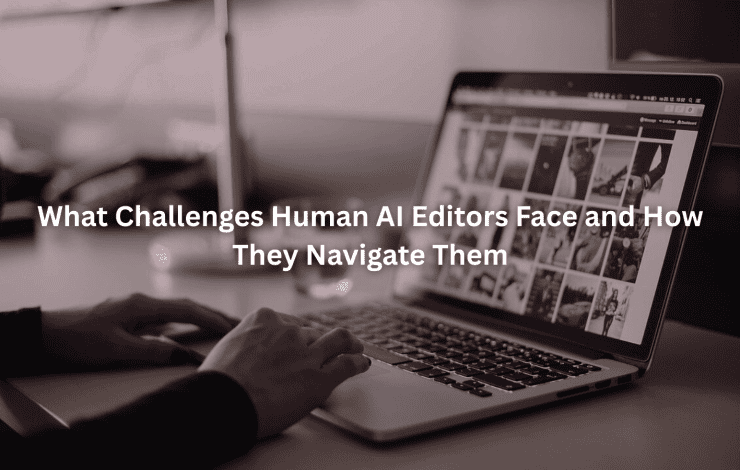You know what’s really getting on everyone’s nerves lately? AI that sounds like a stuck record. God, it’s exactly like that one student who memorized the textbook and won’t shut up about it. Same phrases, same examples, same everything. Makes you wanna throw your computer out the window sometimes.
Getting these computer brains to sound human takes serious work. The tech folks gotta watch every little thing, adjust this, tweak that. It’s like trying to teach your grandma’s parrot to have an actual conversation. Frustrating. Time consuming. But worth it.
The fix isn’t complicated really. Just let it flow natural. People ramble sometimes, right? Other times they barely grunt a response. That’s just how humans work. And that’s exactly what we need from these machines. Real talk.
Key Takeaway
- Mix up how you talk to AI. Don’t be boring. Simple stuff but nobody does it.
- Play with the settings. Turn up the creativity dial when things get stale.
- Human eyes catch what machines miss. Always. No way around it.
Techniques for Reducing AI Repetition
Man, working with AI sometimes feels like being stuck at Thanksgiving dinner with Uncle Bob. You know the type. Tells the same fishing story fifteen times. Here at Jet Digital Pro, we watch these machines fall into the same trap, getting hung up on words like teenagers with their favorite slang. But after banging our heads against this problem for a while (and trust me, there were some rough days), we finally cracked the code. Well, mostly.
Here’s what gets results:
-Tell it exactly what you want, no vague stuff -Switch up how you write things -Throw in some real world examples -Point out what not to do -Break big ideas into bite sized pieces
Sometimes you gotta trick it a little. Ask it about space when you’re talking about oceans. Weird, but it works. Gets the AI thinking differently.
And don’t ask the same question twice. Ever. Change things up, like you would in a real conversation. Even small stuff helps. “How do you fix this” becomes “What’s wrong with this thing anyway?” Totally different answers. Magic.
Prompt Design Strategies
Want the AI to stop being dull? Look, enough with the boring questions already. Who needs another lecture about how dogs are our furry best friends? Snooze. But when you ask something like “Why does my Great Dane think he’s smaller than my cat while my Chihuahua’s planning world domination?” That’s when things get interesting.
And I learned this weird little secret. Just be straight up bossy with AI. For real. Tell it “cut the Wikipedia garbage” or “forget everything you’ve memorized for five minutes.” Sounds mean maybe. But these machines don’t get their feelings hurt. They just… work better when you’re direct. Kinda crazy how being a little demanding gets the best results. Who knew?
User Input Variation
God, talking to AI can feel like being trapped in an elevator with someone who memorized exactly five conversation starters. Pure torture. But check this out: tell it to become a golden retriever writing love poems about tennis balls. Sounds stupid. Works like magic though.
Some of this stuff is just… well, kinda nuts. Forget boring weather questions. Try something like “pretend you’re a cloud having the worst Monday ever, what’s bugging you down there?” Sure, sounds like something my 8-year-old nephew would come up with. But that’s the point. The robot brain short circuits, forgets all its fancy programming, and suddenly starts talking like a real person. Can’t make this stuff up.
Interaction Tips for Reducing AI Redundancy
Real talk. These machines need straight up honesty. Just like my roommate who thinks sarcasm is a foreign language. Tell em “write this like you’re that professor who found his parking spot taken” or “pretend you just hit the Powerball.” Total nonsense. But man, does it work.
And listen up cause this part matters: asking the same question over and over kills the conversation dead. Seriously. Need to know more? Switch things around. Throw in some random trivia. Tell that embarrassing story about your cat. Whatever. These AIs are basically those bored students who suddenly perk up when you start talking about video games in history class. Boom. Instant engagement. Freaky how we can trick computers with the same stuff that works on people, isn’t it?
Model Parameter Optimization for Output Diversity

We’ve spent countless hours tweaking those little numbers that control AI behavior. Temperature settings (those things that control how “creative” the AI gets) need a delicate touch. Too high, and you get nonsense. Too low, and it’s like talking to a particularly dull textbook.
- These are the settings we typically adjust:
- Temperature (0.7 usually works well)
- Topp (around 0.9 for most content)
- Penalty (0.3-0.8 range)
- Presence penalty (0.2-0.6 range)
Our experience shows that each type of content needs its own special mix. Blog posts might need higher creativity settings, while technical writing usually works better with lower ones. We’ve seen dramatic improvements in output quality just by finding the right balance of these numbers.
The trick is knowing when to push for more variety and when to pull back. Through trial and error, we’ve mapped out which combinations work best for different types of content.
Temperature Setting Adjustments
Temperature settings control the randomness of AI responses. In our experience, balancing creativity and relevance is key. A higher temperature can lead to more diverse outputs, but it can also result in less coherent responses. We often play around with different temperature values to find the sweet spot that maximizes creativity without sacrificing clarity.
Effects of high and low temperature values can be striking. While a low temperature may yield safe, formulaic answers, raising it too high can lead to outputs that seem disconnected. Finding the right balance is crucial for our content generation needs.
Frequency and Presence Penalties
Look, there’s these two settings we mess with at Jet Digital Pro. Super boring names, but they basically tell the AI to stop being a broken record. It’s like having a volume knob for repetition. Turn it up, less echo chamber stuff. Turn it down, well… you get the idea.
These tweaks make a huge difference. No joke. When we get them right, the AI actually starts sounding like someone who knows how to hold a conversation. Thank god.
Other Parameter Tuning Techniques
We also play around with this thing called top_p (yeah, terrible name). Think of it like putting guardrails on the AI’s vocabulary. Sounds restrictive but weirdly makes things better. More natural.
And then there’s these fancy algorithms that catch the AI when it starts repeating itself. Like having an editor who slaps your hand every time you write the same thing twice. Sometimes annoying, but it works. Usually combine all this stuff together cause why not use everything in the toolbox, right?
And it’s not just in content work. In HR, for example, AI is already streamlining the repetitive stuff, screening candidates, personalizing onboarding, so humans can focus on the real people’s work like engagement and retention [ 1 ].
Context and Memory Management in AI Systems

Maintaining context and managing memory within AI systems is crucial for avoiding repetitive outputs. Without proper context, AIs often repeat themselves, leading to frustration for users.
Maintaining Conversation History
In our interactions with AI, incorporating previous outputs into the context window is essential. This practice allows the AI to remember what has already been discussed, reducing the likelihood of repetitive statements. By reminding the AI of prior conversations, we create a more coherent narrative flow.
Updating AI memory during sessions can also improve response quality. When we periodically refresh the AI with new information or context, it helps generate responses that feel more relevant and less redundant. This management of conversation history is a critical aspect of effective AI interaction.
Context Window Optimization
Managing input length and relevance is another vital component of context management. By avoiding redundant information feeding, we can help the AI stay focused and produce more meaningful responses. This discipline in our input helps create a more dynamic conversation.
Adaptive response techniques are worth exploring as well. Encouraging the AI to refresh its context dynamically leads to novel content generation. By prompting it to consider new ideas and perspectives regularly, we can keep things fresh and engaging and yeah, knowing how we deal with AI when it starts making stuff up is part of that freshness.
Human Oversight and Post-Processing Methods

Human oversight is an indispensable part of managing AI repetition, especially when you think about the tricky parts human editors face when working with AI content. While AI can generate impressive outputs, it often requires a human touch to polish and refine the content.
Manual Editing and Revision
Detecting and removing redundant phrases is a task we often undertake. Through manual editing and revision, we can ensure that the final output is engaging and free of repetition. Employing synonyms and varied expressions enriches the text, making it more captivating for readers.
Automated filtering techniques can also be useful in this context. By using pattern matching and regex for repetition detection, we can streamline the editing process. These tools help us quickly identify and eliminate redundancies in AI-generated content.
Automated Filtering Techniques
Are You a Digital Agency?
White Label SEO Content Services for Agencies
Scalable, customizable, and results-driven content solutions for your clients.
Secondary validation for output coherence is another layer of oversight we implement, which includes making sure the AI’s facts actually check out. This process evaluates the relevance of AI responses and ensures that they align with our expectations.
Human-AI Collaboration Practices
Over at Jet Digital Pro, we’ve figured something out. People plus AI equals better content. Simple math. As CustomerThink points out, AI can be a powerhouse, but it’s no magic fix for customer experience. The real magic comes from skilled people steering the ship, adding meaning, empathy, and those small touches no machine can replicate [ 2 ].
The machines are smart, sure, but they need that human touch to really shine. Sometimes they get stuck in loops, spitting out the same old stuff they learned from their training. Not great.
But here’s what works: constant back and forth between humans and computers. When someone reads something weird or repetitive, they flag it. The AI learns. Gets better. Like teaching a really fast student who occasionally needs help staying on track.
We’ve been at this for a while now, trying different things. Playing with settings. Tweaking how we ask questions. Managing context. Sometimes it works beautifully, sometimes not so much. Trial and error.
Look, nobody’s saying AI is perfect. But with the right human guidance, it’s pretty amazing what these systems can do. At Jet Digital Pro, we’ve got people who know how to make this stuff work. Real editors working with AI to create content that actually sounds human. Because that’s what matters.
Want content that doesn’t sound like a robot wrote it? Give us a shot. We’ve done the hard work figuring out how to make AI and humans play nice together. No buzzwords. No empty promises. Just solid content that works.
FAQ
How can specific prompt designs help reduce AI repetition in responses?
Specific prompt designs can significantly influence the variety of responses generated by AI. By crafting prompts that encourage different sentence structures and using explicit instructions, we guide the AI to think outside its typical patterns.
For instance, instead of asking a straightforward question, we might provide context or creative scenarios. This approach can help the AI produce more engaging and unique content, ultimately minimizing repetitive outputs.
What role do temperature settings play in managing AI output diversity?
Temperature settings are crucial in controlling how creative or varied AI responses can be. A higher temperature allows for more randomness in the AI’s choices, which can lead to more diverse outputs.
Need a Strategic SEO Content Partner?
Let’s craft SEO content that ranks, converts, and grows your brand.
Talk to UsConversely, a lower temperature may result in safer, more predictable responses. Finding the right balance is essential, as too much randomness can diminish relevance, while too little can lead to repetition. Adjusting this setting helps us optimize the AI’s creativity.
Why is maintaining conversation history important for reducing AI repetition?
Maintaining conversation history is vital for preventing AI from repeating itself. When the AI can reference previous interactions, it avoids restating the same information. By incorporating context from earlier outputs, the AI can build on what has already been said, making its responses more coherent and relevant. This practice not only enriches the conversation but also enhances the overall user experience by promoting a more natural flow of dialogue.
How can human oversight improve the quality of AI-generated content?
Human oversight plays an essential role in refining AI-generated content. While AI can produce impressive text, it often lacks the emotional depth and creativity that humans bring.
By reviewing and editing AI outputs, we can detect repetitive phrases and enhance the overall quality of the content. This collaboration ensures that the final product is engaging and coherent, striking a balance between AI capabilities and human originality.
In what ways can automated filtering techniques assist in reducing AI redundancy?
Automated filtering techniques can be highly effective in detecting and eliminating redundancy in AI-generated content. By employing tools that utilize pattern matching or regex for repetition detection, we can quickly identify repeated phrases.
These automated systems can streamline the editing process, allowing us to focus on enhancing the content rather than spending time sifting through repetitive elements. This efficiency ultimately leads to higher-quality outputs that capture the reader’s interest.
Conclusion
In conclusion, reducing AI repetition takes smart prompt design, fine-tuned model settings, and consistent human oversight. These strategies ensure more original, high-quality content while strengthening the partnership between human creativity and machine intelligence. Fresh ideas are always within reach when both work together.
Want scalable, high-quality SEO content without the workload? Contact JetDigitalPro to discover how our AI efficiency and 11-step human editing process can power your agency’s growth.
References
- https://www.imd.org/blog/digital-transformation/ai-in-hr
- https://customerthink.com/sorry-ai-cant-fix-your-cx-but-talented-humans-can
Related Articles
- https://jetdigitalpro.com/challenges-for-human-editors-of-ai-content/
- https://jetdigitalpro.com/dealing-with-ai-hallucinations-human/
- https://jetdigitalpro.com/ensuring-ai-content-accuracy-human/
P.S – Whenever you’re ready,
we’re here to help elevate your SEO content.
Partner with us for strategic, scalable content that drives real organic growth.
Contact Us Now




